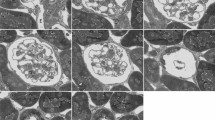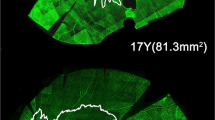Abstract
A computer aided design was developed to support three-dimensional visualisation and modelling of vascular networks. Volume data comprised a series of images obtained using a Zeiss confocal laser scanning microscope. The profiles of vessels were automatically segmented using two-dimensional morphological filters. Segmented contours of the vessels were used to form a spatial model of the network. The centre points of segmented contours were used to derive a three-dimensional graph representing the vascular network. The proposed method was applied to renal capillary networks of normal rats, and showed well the lobular structure of glomeruli. The average length of renal capillary networks was 6.09 mm. Three-dimensional models based on confocal data require much less effort than reconstructions based on serial sections, and can be adapted for any vascular patterns.
Similar content being viewed by others
References
AVS, Inc. (1992): ‘AVS users guide’. Waltham, Massachusetts
Boyer, C. C. (1956): ‘The vascular pattern of the renal glomerulus as revealed by plastic reconstruction from serial sections’,Anat. Rec.,125, pp. 433–441
Culling, C. F. A., andVassar, P. S. (1985): ‘Fluorescence PAS’,in Cullings, C. F. A., Allison, R. T., andBarr, W. T. (Eds.): ‘Cellular pathology technique’, 4th Ed., (Butterworth & Co, London), pp. 230–231.
Deen, W. M., Bridges, C. R., Brenner, B. M., andMyers, B. D. (1985): ‘Heteroporous model of glomerular size selectivity. Application to normal and nephrotic humans’,Am. J. Physiol.,249, pp. F374–389
Deen, W. M., Robertson, C. R., andBrenner, B. M. (1972): ‘A model of glomerular ultrafiltration in the rat’,Am. J. Physiol.,223, pp. 1178–1183
Hibbard, L. S., Grothe, R. A. Jr., Arnicar-Sulze, T. L., Dovey-Hartman, B. J., andPage, R. B. (1993): ‘Computed three-dimensional reconstruction of median-eminence capillary modules: image alignment and correlation’,J. Microsc.,171, pp. 39–56
Interrante, V., Oliver, W., Pier, S., andFuchs, H. (1994): ‘Display methods for gray-scale, voxel-based data sets’,in ‘Three-dimensional confocal microscopy: volume investigation of biological specimens’, edited byStevens, J. K., Mills, L. R. andTrogadis, J. E., San Diego, Academic Press, 1994, pp. 131–167
Kaczmarek, E. (1996a): ‘Quantification of three-dimensional vascular patterns in renal glomeruli’, Proc. 9 ICS Copenhagen, 1995,Acta Stereol.,15/2, pp. 103–200
Kaczmarek, E. (1996b): ‘Visualizing of kidney capillaries with three-dimensional tree structures’, Proceedings of 12 Spring Conference on Computer Graphics. Bratislava-Budmerice June 5–7, 1996 (Comenius University, Bratislava) pp. 77–86. Electronic book:http://www.cg.tuwien.ac.at/~wp/SCCG96-proceedings/
Kaczmarek, E., andBecker, R. L. (1997): ‘Three-dimensional modeling of renal glomerular capillary networks’,Anal. Quant. Cytol. Histol.,19, pp. 93–101
Margadant, F., Leemann, T., andNiederer, P. (1996): ‘A precise light attenuation correction for confocal scanning microscopy with O(n4/3) computing time O(n) memory requirements for n voxels’,J. Microsc.,182, pp. 121–132
Papenfus, H. D., andGross, J. F. (1978): ‘Analytic study of the influence of capillary pressure drop and permeability on glomerular ultrafiltration’,Microvasc. Res.,16, pp. 59–72
Preston, K. (1991): ‘Residue-producing Ξ filters and their applications in medical image analysis’, Proc. SPIE/SPSE Conference on Electronic Imaging Science and Technology,1450, pp. 59–70
Preston, K., Joe, B., Siderits, R., andWelling, J. (1995): ‘Three-dimensional reconstruction of the human renal glomerulus’,J. Microsc.,177, pp. 7–17
Remuzzi, A., Brenner, B. M., Pata, V., Tebaldi, G., Mariano, R., Belloro, A., andRemuzzi, G. (1992): ‘Three-dimensional reconstructed glomerular capillary network: blood flow distribution and local filtration’,Am. J. Physiol.,263, pp. F562-F572
Remuzzi, A., andEne-Iordache, B. (1995): ‘Capillary network structure does not affect theoretical analysis of glomerular size selectivity’,Am J. Physiol.,268, pp. F972-F979
Shea, S. (1979): ‘Glomerular hemodynamics and vascular structure. The pattern and dimensions of a aingle rat glomerular capillary network reconstructed from ultrathin sections’,Microvasc. Res.,18, pp. 129–143
Shea, S. M., andRaskova, J. (1984): ‘Glomerular hemodynamics and vascular structure in uremia: a network analysis of glomerular path lengths and maximal blood transit times computed for a microvascular model reconstructed from subserial ultrathin sections’,Microvasc. Res.,28, pp. 37–50
Shimizu, H., Shinohara, N., andYokohama, T. (1988): ‘Topological analysis of the three-dimensional structure of the human renal glomerulus using a computer aided reconstruction system’,Microvasc. Res.,36, pp. 130–139
Stoyan, D., Kendall, W. S., andMecke, J. (1987): ‘Stochastic geometry and its applications’ (Akademie Vlg., Berlin)
Author information
Authors and Affiliations
Corresponding author
Rights and permissions
About this article
Cite this article
Kaczmarek, E. Visualisation and modelling of renal capillaries from confocal images. Med. Biol. Eng. Comput. 37, 273–277 (1999). https://doi.org/10.1007/BF02513299
Received:
Accepted:
Issue Date:
DOI: https://doi.org/10.1007/BF02513299




